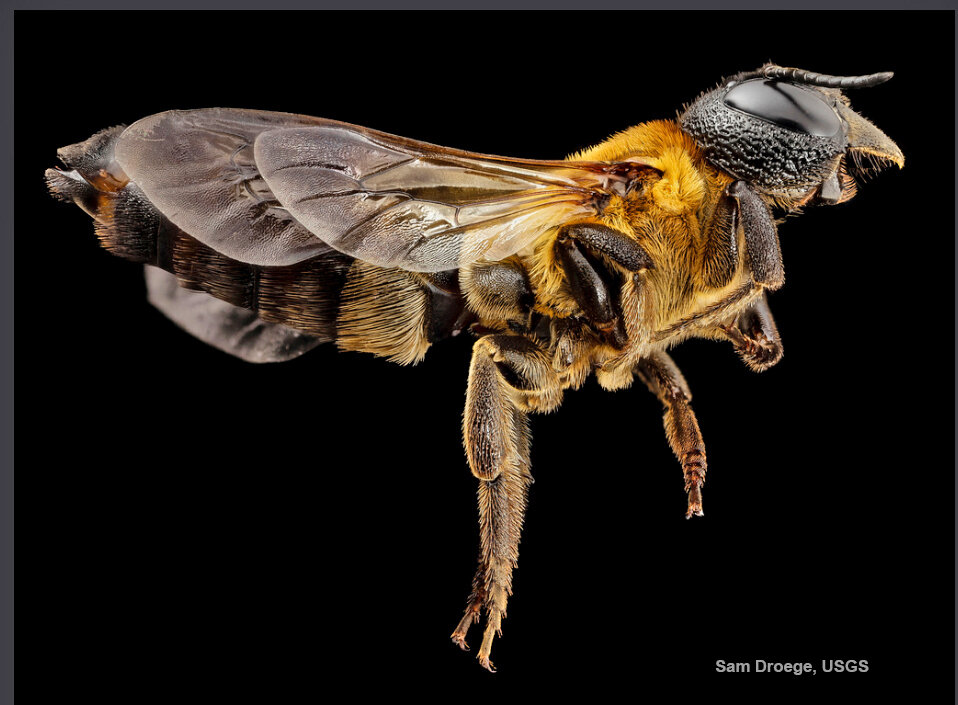Mailbox posts are fine homes for giant resin bees, Megachile sculpturalis

Who’s that checking out the mailbox post? Giant resin bee!
One of the upsides of the ongoing COVID-19 pandemic is a notable increase of folks enjoying time outdoors walking, cycling, and visiting at social distances along neighborhood streets. One steamy morning last week as I circled the block, I noticed surprising numbers of rather large bees buzzing about mailboxes along the streets. Bees interested in postal delivery? A closer look told the tale. Let’s start with the mailbox. If your mailbox is like mine, it rests atop a wooden post some four feet or so above the ground. Over the years the post supporting my mailbox has become home to an occasional colony of carpenter bees. Year after year sometime in May the carpenter bees reliably return to the mailbox post. Males perform aerial battles for dominance of the mail box territory and their mates chew perfectly round holes in the mailbox post, entrances to brood chambers for their young. But in July, as carpenter bee activity wanes, activity around the mailbox post is supplanted by another type of bee. The aerial acrobats now performing near mailboxes are giant resin bees, exotic colonists from Asia first reported in the United States in North Carolina in 1994. In addition to their native Asian range that includes China, Japan, and South Korea, giant resin bees have been discovered in Italy, France, and Switzerland in Europe. In North America they range from Canada to Alabama in most states east of the Mississippi and have been reported in almost all counties in Maryland.

This fantastic enhanced image reveals the beauty of a female giant resin bee. Photo credit Sam Droege, USGS.
Giant resin bees belong to a family of solitary bees known as Megachilidae and are kin to mason bees and leaf cutter bees we met in previous episodes. Like mason bees, each female bee is reproductively active and therefore dissimilar to social bees like honey bees and bumble bees that have a queen. Their presence near a mailbox post riddled with carpenter bee galleries is no mystery. Despite sporting powerful jaws, the potency of which I discovered after handling one, giant resin bees do not excavate galleries in wood. Their sharp jaws are simply not strong enough to do so. Instead, they rely on existing galleries to create a home for their brood. Abandoned galleries of carpenter bees provide perfect chambers to colonize and raise their young. While male giant resin bees spend time defending territories and chasing each other about, female bees gather plant resins to line the inside of the gallery. After each chamber is properly prepared, females collect pollen on fine hairs called scopa on the undersides of their abdomens, return to their galleries, and create pollen balls inside the brood chamber. Eggs are laid on the pollen balls, which serve as the food source for the developing larvae.
On my neighbor’s mailbox post a male giant resin bee arrives to stand guard. When not performing aerial antics, male giant resin bees can be found fanning their wings around co-opted carpenter bee galleries. Does he await the appearance of a lovely lady bee while shooing away other potential suitors?
The ecological impact of these nonnative bees is still largely unknown. They have been observed foraging on several imported plants from their native range including golden rain tree, Koelreuteria paniculata, glossy privet, Ligustrum lucidum, kudzu, Pueraria lobata, and Japanese pagoda tree, Sophora japonica. There is some concern that they may commandeer nesting sites of our native carpenter bees, but the true magnitude of this effect is still unknown. With the abundance of human made habitat for carpenter bees, there may be enough wood to go around for all wood-nesting bees. Who knows? Nonetheless, these goliaths of the solitary bee world are here to stay and they make an interesting study on a walk around the block on a warm summer morning.
Acknowledgements
We thank our gracious neighbors who allowed us to photograph giant resin bees on their mailbox post early one morning and our friends at Woodend Sanctuary for allowing us to film their giant resin bees. The interesting article “Invasive Megachile sculpturalis in Upstate New York” by Robert G. Laport and Robert L. Minckley was consulted in preparation of this episode. Bee guru Sam Droege provided the fantastic image of a female giant resin bee featured in this episode.
This post appeared first on Bug of the Week